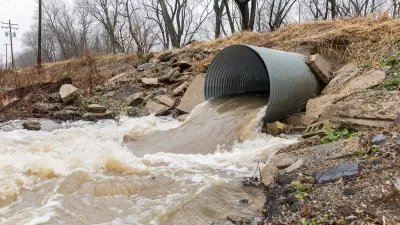Flooding causes over $400 billion in damage in the United States every year.

Flooding is becoming increasingly deadly and costly for American communities. In recent years, the cost of flooding has reached almost $496 billion annually.
In an article in Governing, Carl Smith explains how the crisis is reaching more places — even some thought to be ‘climate havens’ — and how cities are taking action to protect their residents and infrastructure.
To both prepare for potential flooding and conserve water to ensure a steady supply during droughts, cities are building ‘green’ stormwater infrastructure that returns water to the soil and channels it to retention ponds rather than letting it drain to lakes or oceans.
Because watersheds cross multiple jurisdictions, policymakers and planners need to collaborate across cities, counties, and states. “Stormwater needs to be considered as part of the larger water picture. Runoff from city streets or farmland can pollute drinking water. Floods can overwhelm wastewater systems. Ideally, these systems can be integrated in ways that create savings rather than damage. Stormwater retention can recharge aquifers and all sorts of recycled water can be used for drinking.”
FULL STORY: Flooding Is a $400 Billion Problem That's Getting Worse

Planetizen Federal Action Tracker
A weekly monitor of how Trump’s orders and actions are impacting planners and planning in America.

Congressman Proposes Bill to Rename DC Metro “Trump Train”
The Make Autorail Great Again Act would withhold federal funding to the system until the Washington Metropolitan Area Transit Authority (WMATA), rebrands as the Washington Metropolitan Authority for Greater Access (WMAGA).

The Simple Legislative Tool Transforming Vacant Downtowns
In California, Michigan and Georgia, an easy win is bringing dollars — and delight — back to city centers.

The States Losing Rural Delivery Rooms at an Alarming Pace
In some states, as few as 9% of rural hospitals still deliver babies. As a result, rising pre-term births, no adequate pre-term care and harrowing close calls are a growing reality.

The Small South Asian Republic Going all in on EVs
Thanks to one simple policy change less than five years ago, 65% of new cars in this Himalayan country are now electric.

DC Backpedals on Bike Lane Protection, Swaps Barriers for Paint
Citing aesthetic concerns, the city is removing the concrete barriers and flexposts that once separated Arizona Avenue cyclists from motor vehicles.
Urban Design for Planners 1: Software Tools
This six-course series explores essential urban design concepts using open source software and equips planners with the tools they need to participate fully in the urban design process.
Planning for Universal Design
Learn the tools for implementing Universal Design in planning regulations.
Smith Gee Studio
City of Charlotte
City of Camden Redevelopment Agency
City of Astoria
Transportation Research & Education Center (TREC) at Portland State University
US High Speed Rail Association
City of Camden Redevelopment Agency
Municipality of Princeton (NJ)





























